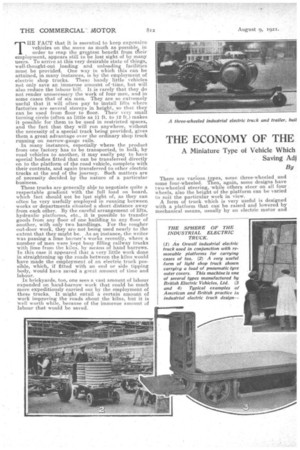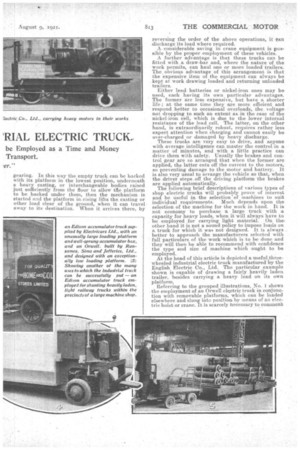THE ECONOMY OF THE 'MAL ELECTRIC TRUCK..
Page 12

Page 13

Page 14

If you've noticed an error in this article please click here to report it so we can fix it.
THE FACT that it is essential to keep expensive vehicles on the move as much as possible, in order to reap the geeatest benefit from their employment, appears still to-lSe lost sight of by many users. To arrive at this very desirable state of things, well-thought-out loading and unloading facilities must be provided. One way in which this can be attained, in many instances, m by the employment of electric shop tracks. These handy little vehicles not only save an immense amount of lime, but will also reduce the labour bill. It is rarely that they do not render unnecessary the work of four men, and in some cases that of six men. They are so extremely useful that it will often pay to install lifts where factories are several storeys in height, so that they can be used from floor to floor. Their very small turning circle (often as little as 11 ft. to 12 ft.) makes it -possible for them to be used in restricted spaces, and the fact that they will run anywhere, without the necessity of a special track being provided, gives them a great advantage over the ordinary shop truck running on narrow-gauge rails.
In many instances, especially where the product from one factory has to be transported, in bulk, by road vehicles to another, it may easily pay to have special bodies fitted that can be transferred directly on to the platform of the road vehicle, complete with their contents, and again transferred to other electric trucks at the end of the journey. Such matters are of necessity decided by the nature of a particular business. .
These trucks are generally able to negotiate quite a respectable gradient with the full load on board, which fact should not be lest sight of, as they can often be very usefully employed in running between works or departments situated a short distance away from each other. By the careful arrangement of lifts, hydraulic platforms, etc., it is possible to transfer goods from any floor of one building to any floor of another, with only two handlings. For the rougher out-door work, they are not being used nearly to the extent that they might be. As an instance, the writer was passing a lime burner's works recently, where a number of men were kept busy filling railway trucks with lime from the kilns, by means of hand barrows. In this case it appeared that a very little work done in straightening up the roads between the kilns would have made the employment of an electric truck possible, which, if fitted with an end or aide tipping body,would have saved a great amount of time and labour.
In brickyards, too_, one sees a vast a-mount of labour expended on hand-barrow work that could be much more expeditiously carried out by theemployment of these trucks. It might entail a certain amount of work improving the roads about the'kilns, but it is Well worth while, because of the immense amount of labour that would be saved.
There are various_types, some three-wheeled and some four-wheeled. Then, again, some designs have two-wheeled steering, -while others steer on all four wheels, also the height of the platform can be varied to suit the -particular work in view.
A form of truck which is very useful is designed with a platform that can be raised and lowered by mechanical means, usually by an electric motor and gearing. In this way the empty truck can be backed with its platform in the lowest position, underneath a heavy casting, or interchangeable bodies raised just sufficiently from the floor to allow tile platform to be backed under them, then the mechanism is started and the platform in.rising lifts the casting or other load clear of the ground, when it can travel away to its destination. When it arrives there, by reversing the order of the above operations, it can discharge its load where required.
A considerable . saving in crane equipment is possible by the proper employment of these vehicles.
A further advantage is that these trucks can be fitted with a draw-bar and, where the nature of the work permits, can haul one or more loaded trailers: The obvious advantage of this arrangementis that the expensive item of the equipment •can always be , kept at work drawing loaded and returning unloaded trailers.
Either lead batteries or nickel-iron ones may be used, each having its own particular advantages.
The former are less expensive, but have a shorter
life ; at the same time they ,are more efficient and respond better to occasional overloads, the voltage.
not dropping to such in extent as in the case of the nickel-iron cell, which is due to the lower internal resistance of the •lead cell. The latter, on the other hand, is extraordioarily robust, requires rather less expert attention when charging and cannot easily be over-charged or damaged by heavy discharge.
These trucks are very easy to drive, and anyone with average intelligence can master the control in a matter of minutes, and with a little practice can drive them with safety. Usually the brakes and control gear are so arranged that when the former are applied, the latter cuts off the current to the motors, so preventing damage to the motor and battery. It is also very usual to arrange the vehicle so that, when the driver steps .off the driving platform the brakes are applied automatically. The following brief descriptions of various types of shop electric trucks will probably prove of interest and be useful in the selection of machines to suit individual requirements. Much depends upon the selection of the machine for the work in hand. It is
not economy to purchase -a, large truck with a capacity for heavy loads, when it will always have to be •employed for carrying light material. On theother hand it is not a sound policy to impose loads on a truck for which it was not designed. It is always .
better to approach the manufacturers selected with full particulars of the work which is to be done and they will then be able to recommend with cenfidenc.e the type and size of -machine which ought to be employed. At the head of this article is depicted a usefuLthreewheeled industrial electric truck manufactured by the English Electric Co., Ltd. The particular example shown is capable of drawing a fairly heavily laden trailer, besides carrying a heavy load on its own platform. Referring to the grouped illustrations, No. 1 shows the .employment of an Orwell ele_ctric truck in conjunction with removable platforms, which can be loaded elsewhere and slung into position by means of an electric hoist or crane. It is scarcely necessary to comment on the immense saving of time that is accomplished by being able to remove the complete load at once and to send it along to its destination, instead of detail handling the various cases shown in the illustration, which would inevitably have to be done without the use of an arrangement of this type.
No. 2 is a useful little truck made by British Electric Vehicles, Ltd. The particular vehicle shown is carrying a load of pneumatic tyre outer covers, and is one of several types made by the company.
No. 3 is an Edison accumulator truck supplied by Electricars, Ltd. This embodies several -interesting features, including a very large loading platform and a remarkably well sprung battery container.
No. 4 is an Orwell electric truck built by Ransomes, Sims and Jefferies, Ltd. In. this machine the accumulators are carried in the raised box, thus permitting the loading platform to be very low, which is often a great convenience when handling very heavy goods such as loaded packing cases, castings, steel *bars,
etc. .
The last illustration of the group shows an Edison accumulator automatic truck, type D, employed for shunting li,ght railway trucks in a large machine shop.
The two Orwell trucks illustrated above should prove of immense -service to builders', contractors, road engineers, and others handling loose material such as sand, gravel, coal, coke, etc. The truck at the left is fitted with an end-tipping body with a tipping arrangement which is particularly interesting. When it is required to tip the load the cranked handle near the driver's end of the vehicle is rotated, and by this means a small countershaft is driven through the medium ef the chain and chain wheel, The countershaft rotating, winds up a chain attached to the bottom of the tipping compartment, and the pull of
this chain causes the compartment to rotate Or roll on the circular guides, of which there is one on either side. Due to the special proportions of the short, heavy and long, light links, tipping takes elace, and at the same time the tailboard, which is hinged at the top and connected at the bottom to the light links is automatically opened.
There are. several other types of industrial eleetrie trucks which we: have not been able to illustrate in this article owing to the restrictions on the space available. One very useful form of truck to which we must refer is that in which the truck is provided with a small crane, while at the same time sufficient platform space is left on it to carry heavy loads of not too great a bulk.
In many cases articles can be carried by the crane Without the necessity for dropping them on to the platform, thus the moving of a heavy component from one 'shop to another can be done with the utmost expedition. One type of Edison accumulator crane truck can lift loads up to a weight of one ton. This machine is provided with booms at right angles to the truck, which prevent the latter from tipping over sideways when a load is being lifted at either side. In cases where the loads are lifted dose tf) the end of the truck, the use of these booms is unnecessary.
It is almost certain that manufacturers, traders and others who have to deal with the transport of large quantities of goods will soon realize the extremely useful sphere of usefulness which can well be occupied by the small industrial electric truck ; its utility as an economical factor is not confined to any one particular kind of employment, althougn, perhaps, its advantages are more apparent in large works where heavy and bulky materials have to be conveyed from shop to shop, and to and from road motors.
































